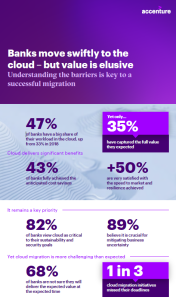
Since the onset of COVID-19, bankers everywhere are talking about cloud. And rightly so, as the benefits of cloud are clear.
The conversation itself hasn’t changed much, but what has changed is timeline. While adopting cloud was a priority before the pandemic, now it is survival.
With so many banks moving at unprecedented speed, the realities of a transition to cloud are coming to the surface. A recent Accenture survey1 revealed some of the challenges, considerations and strategies which are relevant to organizations across various industries that have embarked on cloud journeys. The survey included C-suite executives from banks in 17 countries, all with $1 billion or more in revenue.
Cloud in banking is moving fast, but confidence wanes
Our survey confirmed that more than 90% of banks have at least a moderate level of workloads operating in the cloud, whether public, private or hybrid. Banks are also using cloud more extensively: those who say they have a high share of their workloads in the cloud have increased from 33% in 2018 to 47% in 2020.
While the banking industry is moving rapidly towards a high level of cloud adoption, barely more than 1 in 3 banks were able to capture the full value expected from their cloud initiatives, and only 45% were very satisfied with the results achieved so far. Cost saving is the main driver of satisfaction, as 43% of respondents said they fully achieved their expected outcomes. However, dimensions related to business impact are a barrier: Only 29% of respondents said they fully achieved their expected outcomes related to speed and enablement.
Furthermore, only 32% were completely confident that their organization would deliver the expected value at the expected time—nearly one-third of all cloud migration initiatives had missed their deadlines.
What exactly is in the way of banks capturing the full value of the cloud?
Challenges to cloud initiatives in banking
Security and compliance risks, misalignment between IT and the business, technical legacy and a lack of skills are the greatest barriers impeding banks from realizing their cloud goals.
Barrier 1 – Security and compliance risks:
Our survey exposed a unique discrepancy around security risk. We found that 82% of banks look to cloud for improved security, yet 52% of executives ranked it also as a top barrier.
Regulators’ support for banks’ journey to the cloud is growing, but more work needs to be done. Only one-third of respondents believe that regulators understand and support the cloud journey, but it varies by region—with a high of 50% in the US and APAC and a low of 19% in Europe.
What you should be thinking of now:
Look at using your regulatory forums and industry associations to educate and synchronize on the benefits and approach of moving banking capabilities to the cloud. Working together with industry leaders and cloud service providers can build momentum and deepen regulators’ understanding of banks using cloud and how it can be just as secure, if not more so, than what you use today.
Barrier 2 – Misalignment between IT and the business:
Poor alignment of banks’ technology and business objectives is simultaneously a barrier and an opportunity. As a barrier, this disconnect has grown since 2018. But for companies that can figure this out, the synergy between IT and the business can be a powerful market differentiator.
What you should be thinking of now:
Think about what products and services could be prioritized now that would be accelerated using cloud technology. We’ve seen numerous cases globally around payments, small business, corporate banking, and many other areas where banks are attacking markets with new products using cloud-first solutions.

Banking Cloud Altimeter | Volume 6: Banks need a flight plan to navigate the cloud.
LEARN MOREBarrier 3 – Legacy infrastructure and application sprawl:
Moving core applications to the cloud is the apex of banking. We are going to publish more on this topic, but in the meantime the survey highlights legacy sprawl as a critical obstacle. The challenge is that legacy code is often highly efficient, banking products globally are stable, and moving to the cloud can be expensive. This adds up to a difficult business case for migration.
This is the most complex barrier to overcome, but it’s not impossible. As with many of these barriers, there’s an opportunity here. We’ve helped many banks crack their business case open and move towards a true cloud-based solution.
What you should be thinking of now:
Start with prioritized product use cases in areas that are undergoing dramatic change. This can vary widely by product and region, for example payments in North America and wealth management in Europe. You can leverage areas in flux to migrate or build cloud-native products.
Barrier 4 – A shortage of cloud skills:
It’s a war for talent, and our survey confirmed it: 41% ranked “lack of cloud skills within the organization” as one of their top three barriers. A shortage of tech skills is nothing new to banks. This same barrier confronted banks when they had to create their first websites, and again when they had to go mobile. Those solutions required both in-house and third-party partners. Ultimately, it led to a surge in capabilities, talent, and learning.
What you should be thinking of now:
Training can help, but there’s no substitute for real-life learning. Internally, focus on execution. Then leverage partners to bring in expertise and best-of-practice capabilities, just like banks did when they moved from online to mobile.
In many ways, these survey results follow trends and highlight concerns around cloud in banking that we’d expect. However, there were also some compelling and distinctive clashes with some of the survey answers around security and skills gaps. Overall, cloud migrations can be massive and overwhelming, but they are crucial to future flexibility, responsiveness and survival.
More to come. We are conducting further research very specific to the core functional areas of a bank, and look forward to sharing the findings with you. In the meantime, contact me if you would like to discuss how we can help you plan, implement, or refine your current or future cloud migration.
Download the infographic for an overview of the data discussed above.









